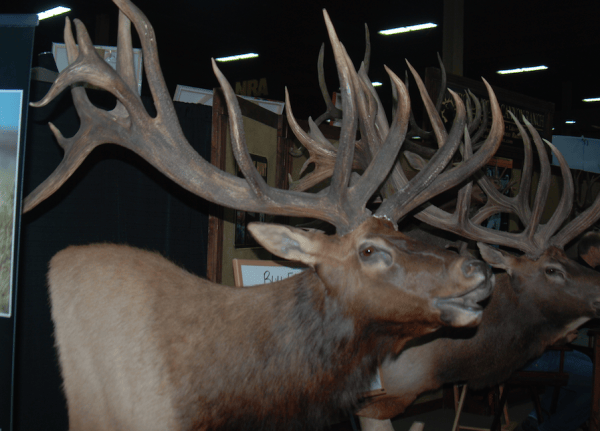By Jason Reid


United States -(AmmoLand.com)- With all the fantastic elk mounts hanging at the Safari Club International convention, it is hard to not ask questions and listen to as many different guides and experienced hunters as possible.
Learning how to hunt elk more effectively can take place in two ways. One is boots on the ground experiences in the mountains, the other is listening to seasoned elk hunters and picking their brains. Here are different tips I picked up from people on how to hunt elk. Whether you hunt with a guide or on your own, it is important to have an understanding.
Planning Your Hunt: You must decide what kind of hunt you want. Do you want to camp on the road and hike in? Do you want to hike in with your camp on your back and set up five miles from the trailhead? Or can you afford to own or hire horses to take you ten or more miles into the backcountry? Each hunt has its advantages and disadvantages. Rookie elk hunters should note elk are very sensitive to pressure. Pressure is everything. Remember, don’t camp among the elk. Give them plenty of space if you have pre-scouted an area and know where they like to hang out.
Packing Out: This question is posed by many. If I kill one way back in there, how am I going to get it out? This deters many from hunting tough canyons and basins. Ask yourself how you are planning on getting a bull to the cooler before you ask where to kill one. Too many put this issue on the back burner and can lose the precious meat when they have a bull down. If you are going to just have to carry the meat on your back, commit to this long before the hunt and get in shape. If you own stock, awesome. If you are going to hire a cowboy, start saving.
Finding Elk: Timber is key. Elk have such thick hides, they retain heat extremely well. A huge mistake first time hunters make is by looking for elk on the wrong sections of the mountain. The South facing timber on the mountains is a better place to find mule deer. Those specifically targeting elk should look for the North facing patches of timber which provides relief from the sun since the sun does not directly shine on those pieces. The best way to hunt the dark timber is to still hunt it like you would for deer.
Pre-identify on your maps and GPS pieces of Northern facing timber so you don’t lose valuable time in the mountains trying to find them.
Still Hunting: This is such an overlooked aspect of the hunt since we are wired to want to call them into shooting distance. If you cannot call or don’t have confidence in calling just yet, slipping through timber and using your optics to pick apart the sticks to find the hide and antlers of an animal is a very effective way to get in tight for a shot. This is particularly effective during the post-rut when most of the rifle seasons take place in the West. After the rut, bulls want to be left alone to recover. They can be found in thick cover which can leave them vulnerable if you can approach them strategically.
Gear: Have confidence in your gear. If you bow hunt, know your limits. If you decide to hunt with a gun, pick a rifle and cartridge which can handle bush well.
Unless you are a long range fanatic, having the ability to shoot through sticks is essential for a rifle elk hunt.
Elk hunting is part mental, part physical, but takes total commitment. Regardless if you decide to hunt with a guide or on your own, you must go into the hunt being totally committed to the pain and frustration of elk hunting. Planning is key to any elk hunt and the more you can learn from others who have been successful, the better off you will be when you hit the mountain.
About Jason Reid:
Jason Reid is a writer and business professional from upstate New York. After deciding to pursue his dream of becoming an outdoor writer, Jason started a blog from his dorm room at Houghton College, growing it and working hard to earn opportunities. While bowhunting big game is his ultimate passion, Jason welcomes all outdoor challenges which force him to push his limits. See more from Jason on Facebook, Twitter, and Instagram.
Jason’s work can also be viewed on his website Pushingthewildlimits.com.
